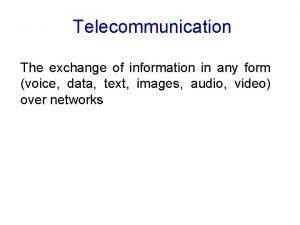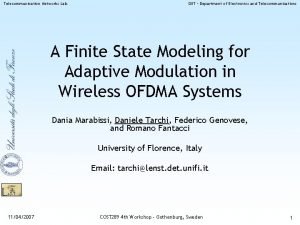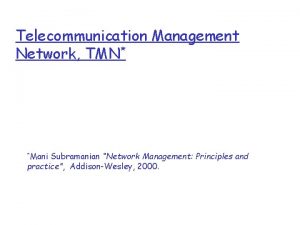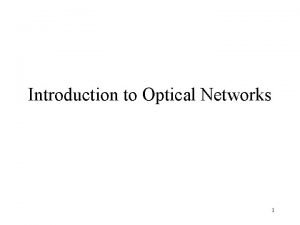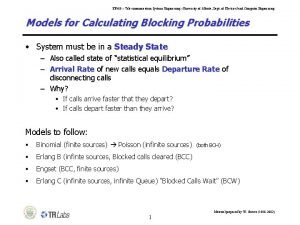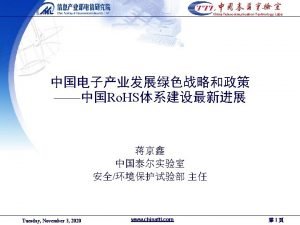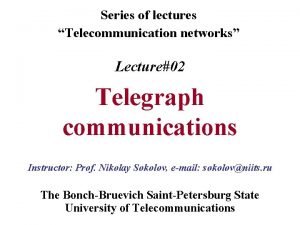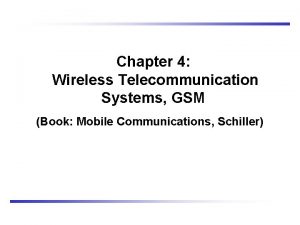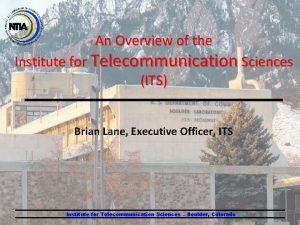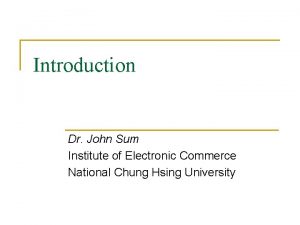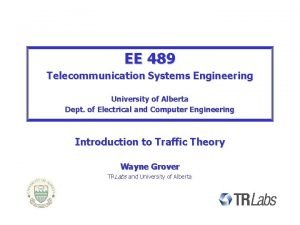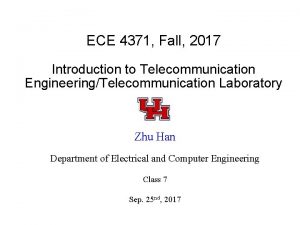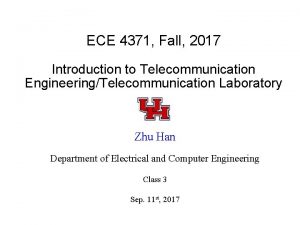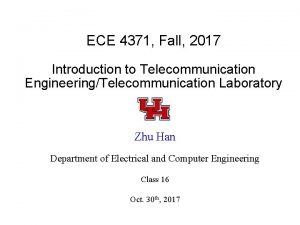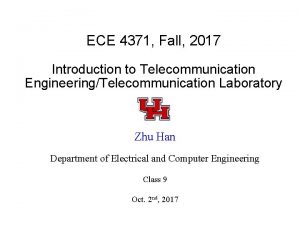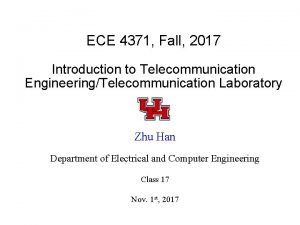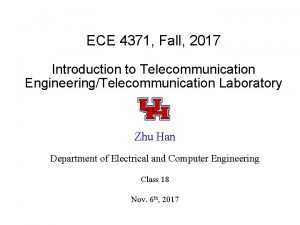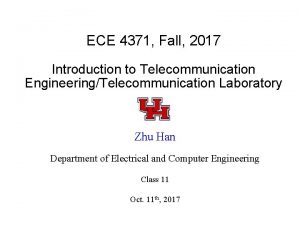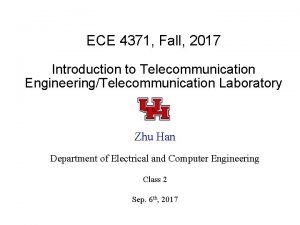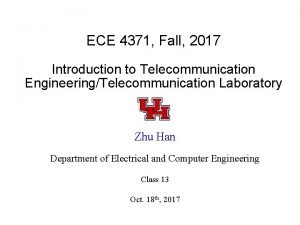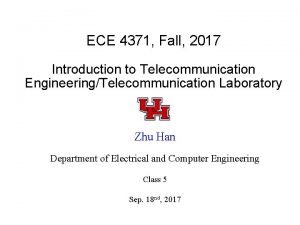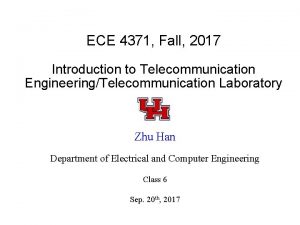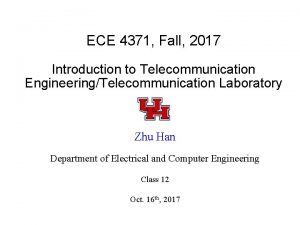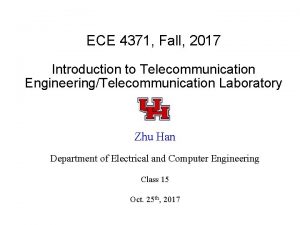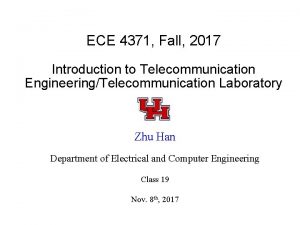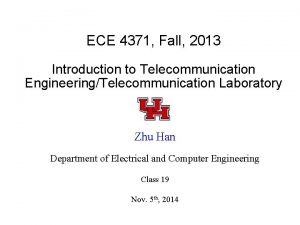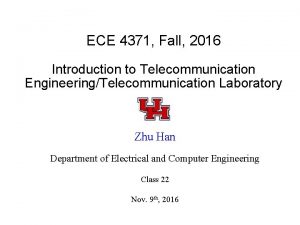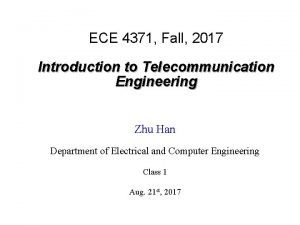ECE 4371 Fall 2017 Introduction to Telecommunication EngineeringTelecommunication



























- Slides: 27

ECE 4371, Fall, 2017 Introduction to Telecommunication Engineering/Telecommunication Laboratory Zhu Han Department of Electrical and Computer Engineering Class 4 Sep. 13 th, 2017

FM Modulator and Demodulator l l l Review of FM FM modulator – Direct FM – Indirect FM FM demodulator – Direct: use frequency discriminator (frequency-voltage converter) – Ratio detector – Zero crossing detector – Indirect: using PLL l l l Superheterodyne receiver FM broadcasting and Satellite radio Project 1

Review of last class l PLL and math l Instantaneous frequency l FM and PM l Modulation index l Narrow band FM characteristics l Carson’s rule LPF VCO

FM Direct Modulator l Direct FM – Carrier frequency is directly varied by the message through voltage-controlled oscillator (VCO) – VCO: output frequency changes linearly with input voltage – A simple VCO: implemented by variable capacitor – Capacitor Microphone FM generator

FM Direct Modulator cont. l Direct method is simple, low cost, but lack of high stability & accuracy, low power application, unstable at the carrier frequency l Modern VCOs are usually implemented as PLL IC l Why VCO generates FM signal?

Indirect FM l Generate NBFM first, then NBFM is frequency multiplied for targeted Δf. l Good for the requirement of stable carrier frequency l Commercial-level FM broadcasting equipment all use indirect FM l A typical indirect FM implementation: Armstrong FM l Block diagram of indirect FM

Indirect FM cont. l First, generate NBFM signal with a very small β 1 m(t)

Indirect FM cont. l Then, apply frequency multiplier to magnify β – Instantaneous frequency is multiplied by n – So do carrier frequency, Δf, and β – What about bandwidth?

Analysis of Indirect FM

Armstrong FM Modulator l Invented by E. Armstrong, an indirect FM l A popular implementation of commercial level FM l Parameter: message W=15 k. Hz, FM s(t): Δf=74. 65 k. Hz. l Can you find the Δf at (a)-(d)?

FM Demodulator l Four primary methods – Differentiator with envelope detector/Slope detector u FM to AM conversion – Phase-shift discriminator/Ratio detector u Approximates the differentiator – Zero-crossing detector – Frequency feedback u Phase lock loops (PLL)

FM Slope Demodulator l Principle: use slope detector (slope circuit) as frequency discriminator, which implements frequency to voltage conversion (FVC) – Slope circuit: output voltage is proportional to the input frequency. Example: filters, differentiator

FM Slope Demodulator cont. l Block diagram of direct method (slope detector = slope circuit + envelope detector) so(t) linear with m(t)

Slope Detector Magnitude frequency response of transformer BPF.

Bandpass Limiter l A device that imposes hard limiting on a signal and contains a filter that suppresses the unwanted products (harmonics) of the limiting process. l Input Signal l Output of bandpass limiter l Bandpass filter l Remove the amplitude variations

Ratio Detector l Foster-Seeley/phase shift discriminator – uses a double-tuned transformer to convert the instantaneous frequency variations of the FM input signal to instantaneous amplitude variations. These amplitude variations are rectified to provide a DC output voltage which varies in amplitude and polarity with the input signal frequency. – Example l Ratio detector – Modified Foster-Seeley discriminator, not response to AM, but 50%

Zero Crossing Detector

FM Demodulator PLL l Phase-locked loop (PLL) – A closed-loop feedback control circuit, make a signal in fixed phase (and frequency) relation to a reference signal u u Track frequency (or phase) variation of inputs Or, change frequency (or phase) according to inputs – PLL can be used for both FM modulator and demodulator u Just as Balanced Modulator IC can be used for most amplitude modulations and demodulations

PLL FM l Remember the following relations – Si=Acos(wct+ 1(t)), Sv=Avcos(wct+ c(t)) – Sp=0. 5 AAv[sin(2 wct+ 1+ c)+sin( 1 - c)] – So=0. 5 AAvsin( 1 - c)=AAv( 1 - c)

Superheterodyne Receiver l Radio receiver’s main function – – l Demodulation get message signal Carrier frequency tuning select station Filtering remove noise/interference Amplification combat transmission power loss Superheterodyne receiver – Heterodyne: mixing two signals for new frequency – Superheterodyne receiver: heterodyne RF signals with local tuner, convert to common IF – Invented by E. Armstrong in 1918.

Advantage of superheterodyne receiver l A signal block (of circuit) can hardly achieve all: selectivity, signal quality, and power amplification l Superheterodyne receiver deals them with different blocks l RF blocks: selectivity only l IF blocks: filter for high signal quality, and amplification, use circuits that work in only a constant IF, not a large band

FM Broadcasting l The frequency of an FM broadcast station is usually an exact multiple of 100 k. Hz from 87. 5 to 108. 5 MHz. In most of the Americas and Caribbean only odd multiples are used. l fm=15 KHz, f=75 KHz, =5, B=2(fm+ f)=180 k. Hz l Pre-emphasis and de-emphasis – Random noise has a 'triangular' spectral distribution in an FM system, with the effect that noise occurs predominantly at the highest frequencies within the baseband. This can be offset, to a limited extent, by boosting the high frequencies before transmission and reducing them by a corresponding amount in the receiver. l Block diagram and spectrum l Relation of stereo transmission and monophonic transmission

FM Stereo Multiplexing Fc=19 KHz. (a) Multiplexer in transmitter of FM stereo. (b) Demultiplexer in receiver of FM stereo. Backward compatible For non-stereo receiver

TV FM broadcasting l fm=15 KHz, f=25 KHz, =5/3, B=2(fm+ f)=80 k. Hz l Center fc+4. 5 MHz l Eye cells structure

XM vs. Sirus

Frequency Allocation ECE 4371 Fall 2008

Project 1 l Project 1 – AM/FM/Real voice – Due 10/1/17
 Telecommunication processors
Telecommunication processors Njdv
Njdv Project management telecommunications
Project management telecommunications Objectives of telecommunication
Objectives of telecommunication Types of telecommunication networks
Types of telecommunication networks Advantages of star topology
Advantages of star topology Kyushu telecommunication network co.,inc.
Kyushu telecommunication network co.,inc. Telecommunication
Telecommunication Tmn functional architecture
Tmn functional architecture Swift finance retrievals
Swift finance retrievals Telecommunication network architecture
Telecommunication network architecture Telecommunication
Telecommunication Global telecommunication system
Global telecommunication system Telecommunication trends
Telecommunication trends Global telecommunication system
Global telecommunication system Itu world telecommunication indicators database
Itu world telecommunication indicators database Jelaskan jaringan telekomunikasi wireless
Jelaskan jaringan telekomunikasi wireless China telecommunication technology labs
China telecommunication technology labs Telecommunication
Telecommunication Telecommunication sealing technology
Telecommunication sealing technology Telecommunication systems book
Telecommunication systems book Institute for telecommunication sciences
Institute for telecommunication sciences World telecommunication standardization assembly
World telecommunication standardization assembly Txpdr
Txpdr Types of telecommunication networks
Types of telecommunication networks Telecommunication
Telecommunication Telecommunication closet
Telecommunication closet Telecommunication
Telecommunication




